Delightful Descriptive Writing Exercises and Worksheets
Descriptive writing is an attempt to give a clear description of people, places, objects, or events using descriptive language and informative details. Descriptive writing exercises can include:
- brainstorming
- word sorting
- sentence writing with pictures
- transitions exercises

1 Descriptive essay outline template
This is an essay outline worksheet to help students focus on organization and planning when preparing to write essays. It helps them write clearly and logically.
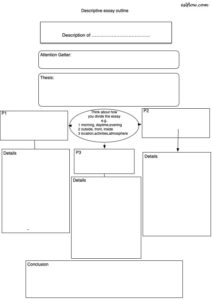
Descriptive essay outline template (PDF)
2 Brainstorming for a descriptive essay about a place
This is an English language writing exercise for students to brainstorm ideas for a descriptive essay.
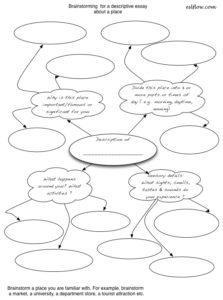
Brainstorming descriptive writing ideas (PDF)
3 Descriptive writing word sorting (with answers)
This is an exercise that helps students expand their vocabulary and shows them that there are many words available to help them write more creatively and with more attention to detail.

Descriptive writing word sorting (PDF)
4 Essential shapes vocabulary
This worksheet is designed to help students learning English become familiar with vocabulary for shapes. Students match the vocabulary to the pictures.

(download PDF)
Related Resources:
6 narrative essay writing templates and worksheets
8 comparison/contrast templates and exercises
10 cause/effect writing activities
11 essential basic exercises for paragraph/essay writing
3 kinds of exercises for teaching transitions
5 Descriptive sentences practice
This is an English language writing exercise for students to practice writing descriptive sentences. Students look at the pictures and try to write between two and five sentences.
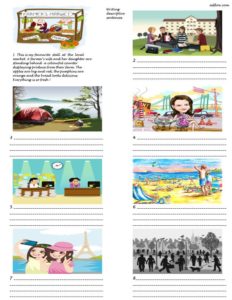
Writing descriptive sentences (PDF)
6 The Weekend Market (descriptive essay transitions with answers)
This is a transitions and linking words exercise for a descriptive essay. Well placed transitions help make essays easier to read and understand.
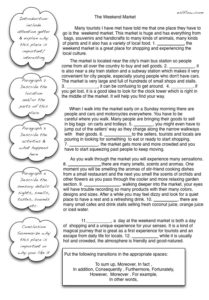
Descriptive essay transitions exercise (PDF)
(see the video on YouTube)
7 Descriptive Paragraphs ( transitions exercise with answers)
This is an English language exercise to help students understand transitions. Students try to fill in the blanks with the words below each paragraph.

Descriptive paragraph transitions exercise (PDF)

14 Replies to “Descriptive writing exercises and worksheets”
Necesito saber las respuestas del ejercicio 4 porfa???
Great resource! Thank you
Thanks for sharing this excellent material!
Excellent and greatly helpful. Thank you very very much. wonderful!
Useful resource.Thank you
Thanks fo the comments!
These are very fruitful. Thanks indeed.
These have been some wonderful exercises for my students as we learn descriptive writing.
terima kasih
Excellent and exactly what we need! Thank you :))
Very useful. Thank you.
great worksheets
It is a wonderful teaching writing source. I thank you!
The content is awesome… Very apt for beginners. Thank You
Leave a Reply Cancel reply
Your email address will not be published. Required fields are marked *
Save my name, email, and website in this browser for the next time I comment.
This site uses Akismet to reduce spam. Learn how your comment data is processed .
RECENT ESL EXERCISES
- Essential listening exercises for ESL classes
- Daily routines and schedules
- Sentence starters
- Writing topic sentences
- Shopping online listening, speaking and vocabulary
- Import/export, logistics and supply chain exercises
- Create a conversation
- Using comparative adjectives
- Gerunds and Infinitives Grammar, Speaking and Listening Activities
You are using an outdated browser. Please upgrade your browser or activate Google Chrome Frame to improve your experience.
8 ESL Descriptive Writing Activities
These sentences get the point across:
I could smell the peppers. It was dinner time. I washed my hands.
But we can make them more detailed and engaging :
The sweet, burnt scent of roasting peppers hung in the air. I knew dinner was almost ready. I washed my hands, watching the dirt swirl around the sink and disappear.
How do you get your ESL students from the first example to the second? By introducing them to the wonders of descriptive writing!
The descriptive writing activities listed in this post can be adapted for any age group and all levels of ESL learners. With a little guidance from you, your students will be writing wonderfully descriptive sentences in no time.
8 Activities for Introducing ESL Students to Descriptive Writing
1. transform non-descriptive sentences to descriptive, 2. describe a painting or picture, 3. describe an object, 4. describe a restaurant, 5. describe your best friend or family member, 6. describe a favorite food, 7. describe your favorite room at home, 8. describe your best or worst vacation, why teach descriptive writing to esl students, how to make students aware of descriptive writing, literary devices, the five senses, reading for imagery.
Download: This blog post is available as a convenient and portable PDF that you can take anywhere. Click here to get a copy. (Download)
Here are some descriptive writing activities that will encourage your students to get creative with the English language! You can even tweak any of them to focus on certain categories of vocabulary words, such as food or travel.
Prepare a worksheet with sentences that are rather basic and lacking description. Students must transform these sentences into more descriptive sentences. Remind your students to use their five senses and literary devices.
For example:
It was cold.→The air was frigid and I couldn’t feel my ears.
The car was red and fast.→The car was apple-red and could easily go 120 miles per hour.
Students can work individually or in pairs. They should share their sentences at the end of class.
Print out a selection of images. You can use famous paintings or photographs.
Assign a different image to each student, then ask them to describe it using their five senses, literary device and adjectives.
Give them a sufficient amount of time to think about it. Then, collect the images again and display them in front of the classroom. Students will then read their descriptions, and the rest of the class will try to determine which image the student is describing.
Let students choose an object and write a description of it for 10 minutes. Set a word minimum or maximum limit as needed and encourage them to be as descriptive as possible.
You can implement different guidelines. For example, “you can’t use any color names” or “you must use all five senses” or “you must use one literary device.”
Once they’re ready with their descriptions, students take turns reading their descriptions. The rest of the class must try to guess the object their classmate describes.
For this activity, challenge your students to write their own descriptive paragraphs.
Have them describe their favorite restaurant. In a restaurant, all your senses are turned on and sight may be overwhelmed by smells and sounds .
At the end of class, ask for students to volunteer to share their descriptions before you collect their work.
This activity is great for focusing on other types of descriptions. In addition to describing appearances, students may also describe things such as mannerisms, feelings and characteristics .
Students should share their descriptions with the class.
I like this activity because it’s easy for students to simply describe the taste or sight of their favorite food, but they should also work on describing the smell of the food as it is prepared and the texture of the food in their mouths.
You can introduce different vocabulary related to food such as: salty, bitter, sweet and spicy.
Again, make sure you save time at the end of class for students to share their descriptions.
Another nice activity that gets students thinking is describing their favorite room in their home.
Students should think about size, colors, the atmosphere and furniture, among other things. Make sure you ask them to say why it’s their favorite room.
Save time at the end of the lesson for them to share what they wrote if they want.
This activity encourages students to bring their reader into the vacation. They must describe the setting, order of events and the people who were with them.
If you have time, encourage them to write about both a great vacation and an awful vacation, which will make them work with descriptions and words of both positive and negative connotation.
Descriptive writing can be summed up in one short statement: Show, don’t tell.
Descriptive writing creates a clear image in the reader’s head. It describes something or someone accurately and in a way that makes it come alive for the reader.
For ESL learners, practicing descriptive writing can not only enhance their writing but also be a fun and creative way to practice English. After all, descriptive writing exposes them to some of the more subtle and beautiful aspects of the English language, such as diverse vocabulary and literary devices like similes and personification.
Begin with explaining some of the general ideas of descriptive writing. Before students can write descriptively, they must understand the basics of descriptive writing.
Aside from having a solid list of adjectives and adverbs at their fingertips, they should be familiar with the following concepts:
Descriptive writing is more than just using adjectives and adverbs. Literary devices can help writers write descriptively.
Here’s a sample list of useful literary devices. Choose what you want to introduce depending on the level of your students:
- Alliteration: The repetition of a sound or letter in words close to each other.
- Imagery: The visual description of something.
- Onomatopoeia: Words that sound like the sounds they describe.
- Personification: Giving inanimate objects living attributes.
- Simile: Comparing two things with the words “like” or “as.”
Practice using these devices by having students create individual sentences for each. Give students a chance to share their sentences with the whole class.
Another key element to good descriptive writing is using all five senses . Most of the time, students get into the habit of describing only what can be seen. However, it’s important to incorporate all of the senses: taste, touch, sight, smell and sound.
Write the five senses on the board, and list down relevant adjectives under each. Encourage students to share as many adjectives as they can think of.
Then ask your students to think of different ways to describe the classroom using different senses. What do they see? What do they hear? What does the classroom smell like? What does it feel like to sit in the classroom? Since the classroom has no taste (hopefully), for the taste column you can ask students to describe what they ate that morning.
Ask your students to write a few sentences individually and give them a chance to share with the class.
Another great way to introduce the idea of descriptive writing to your students is to have them read some examples. Read a descriptive passage (either your own or one you found online) and have students identify the literary devices and senses that are used.
Alternatively, you can give them two passages to compare and contrast, one that’s lacking descriptive language and one that describes the same thing, but more creatively.
Take it one step further by removing some of the descriptive language and asking students to use their own words to complete the passage.
These activities will really get your students thinking about writing and writing descriptively. And remember, get creative yourself! Descriptive writing can be applied to just about any topic.
Happy writing!
Enter your e-mail address to get your free PDF!
We hate SPAM and promise to keep your email address safe


How to Write a Descriptive Text
WHAT IS A DESCRIPTIVE TEXT?
A descriptive text usually describes a single location, object, event, person, or place. It endeavors to engage all five of the reader’s senses to evoke the sights, sounds, smells, tastes, and feel of the text’s subject.
As with all writing genres, we can guide our students on how to best organize and structure a descriptive text effectively.
In this article, we’ll take a closer look at how to choose a topic for a descriptive text, prepare an outline, and ultimately produce a well-written descriptive text.
Let’s get started!

THE STEPS TO WRITING A GREAT DESCRIPTIVE TEXT
Step #1 select a topic.
Generally, descriptive texts are narrow in focus. This allows for an in-depth exploration of the subject. If ever the old adage show, don’t tell applied to a writing genre , descriptive texts are it.
Whether you are choosing a topic for your students, or they are choosing what to write about themselves, be sure the topic is something that can sustain their interest, as well as the reader’s interest.
Descriptive essays require the writer to go into great depth to evoke the person, place, or thing. If the writer doesn’t care about the topic, then for sure the reader won’t either.
A good starting point for many students is to ask them to write about something that is very personal to them. For example, childhood memories, embarrassing moments, or a favorite holiday make good topics.
As the purpose of a descriptive text is to describe something so vividly, and to express emotion so clearly, that the reader can feel it too, personal topics can provide the perfect material for this type of essay.
It is easier for us to describe those things we have intimate knowledge of. This is why memories make such rich fodder for this type of essay.
We can think back to what things looked like, sounded like, smelled like, tasted like, and felt like. We can reconjure in our mind’s eye what it was like to experience that memory at the time, making it easier for us to recreate it again in the minds of our readers.
It is worth investing some time to select a suitable topic for a descriptive text. A well-chosen topic can go a long way to kick-starting some good writing by your students.
A COMPLETE UNIT ON TEACHING EXPLANATION TEXTS
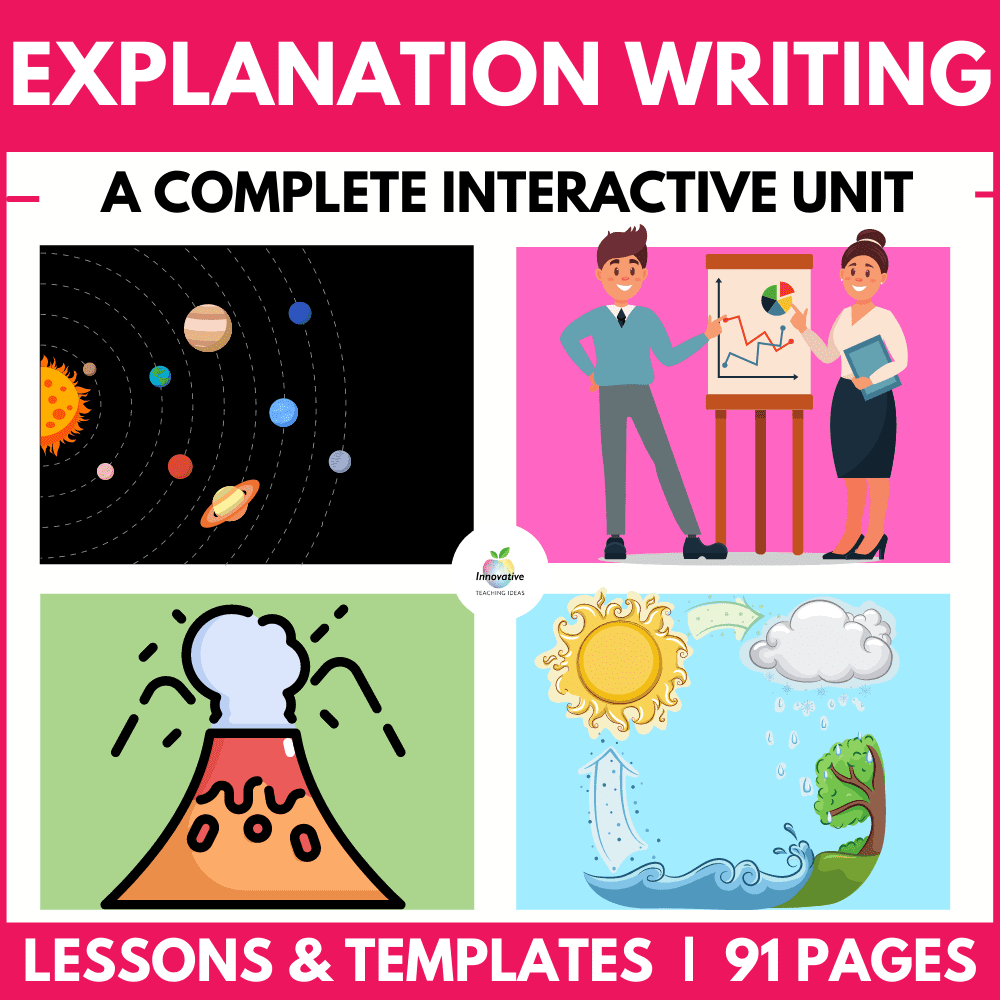
Teaching students to write instruction manuals, recipes and science experiments can be challenging for the creative writer and teacher… ⭐ UNTIL NOW ⭐ Because the PERFECT PROCEDURAL WRITING UNIT offers a complete solution to teaching all styles of procedural writing, including,
⭐⭐⭐⭐⭐ (116 Reviews)
STEP #2 WRITE A THESIS STATEMENT

The purpose of a descriptive essay is also to inform the reader on a particular topic, event, or experience.
However, some topics are extremely broad and without setting out a clear focus for their writing, there is a danger that students writing can veer off course as they scramble to share with the reader everything they know about their chosen topic.
To avoid this, it is essential that students narrow down which aspects of their selected topic their essay will concern itself with. An effective means of doing this is by writing a thesis statement.
The thesis statement lays out the specific purpose of the text and usually it is embedded in the introductory paragraph.
While it can be difficult at times for students to define their thesis statement for a descriptive text, the following process should help guide students:
- Choose an interesting topic
- Reflect on what you think about this topic
- Consider the reasons for your point of view
- Compose a statement that encapsulates this viewpoint.
Following the process above will help students to write a thesis statement that performs the two defining tasks of a thesis statement, namely:
i. To define the topic
ii. To state a viewpoint.
While the thesis statement in a descriptive essay is not as central as in, say, a persuasive essay , it still serves the important function of orienting the reader while providing the writer with a clear focus for their energies.
STEP #3 EVOKE THE SUBJECT’S ESSENCE
The clue is the title! To evoke the subject in the minds of the readers, your students will need to drill down into the essence of the thing itself.
So, how can we convey this essence in the printed word?
We experience the world around us through our senses and it is through the use of sensory language that our students will evoke the essence of the thing they are writing about.
To help your students do this, have them create a five-column table on a sheet of paper.
Each column will be labelled with the name of one of the five senses: sight, sound, smell, taste, touch. Students will then brainstorm the various feelings and sensations they associate with their essay’s topic, and they’ll then list their ideas in the appropriate column on the sheet of paper.
While, for the most part, descriptive texts are nonfiction texts, there is still plenty of room here for students to exercise their creative faculties.
Encourage students to employ literary devices such as simile, metaphor, and personification to bring their sensory descriptions to life. This can also be a great opportunity to reinforce student understanding of the various literary devices themselves.
You can also encourage students to use a thesaurus to uncover suitable and interesting adjectives to help them evoke the essence of the thing itself.
Not only will this help them to produce a well-written descriptive text, but it will give them the opportunity to enhance their vocabulary as they work.
As students fill out the various details they have selected, remind students it’s important to always refer back to their thesis statement.
Remember, every point a student makes in their essay should be in support of their thesis statement.
STEP #4 CREATE AN OUTLINE
Now that your students have selected an engaging topic, produced a solid thesis statement, and gathered together lots of relevant sensory detail, they’ll need to create a clear outline to organize and inform the writing process .
As with many types of essays, the standard five-paragraph essay structure will serve well here. This structure works as follows:
Paragraph 1: The opening paragraph introduces the main topic viewpoint of the essay. This will usually include a thesis statement.
Paragraphs 2,3, & 4: These are considered the body paragraphs of the essay, with each paragraph exploring one of the supporting arguments that prove the thesis statement. More body paragraphs may be added as needed.
Paragraph 5: The purpose of the conclusion paragraph is to restate the thesis statement, summarize the various points made in the essay itself, and to leave the reader with something to think about.
This standard format provides a helpful template for students to outline their descriptive text before writing. It will help ensure their writing stays focused and moves forward in a coherent manner.

STEP #5 WRITE, WRITE, WRITE!
By this stage, students have laid more than enough groundwork to get started writing in earnest.
While they should refer closely to the prep work they have done already, students should also be encouraged to let things flow too.
Writing is as much art as it is science. Having a clear, disciplined structure in place from the previous steps will allow students the freedom to take chances and get creative in their writing.
Sometimes students at this stage find it difficult to let go in their writing. They want things to be perfect the first time round.
Remind them that they shouldn’t be afraid to write less than perfect sentences in their first drafts. Getting their ideas on paper is the most important thing at this stage. They can always edit and rewrite later.
It’s important that students understand that good descriptive writing is not only filled with physical details, but includes emotional content too. Encourage your students to include the emotional significance of memories and events, people and places, too. This brings meaning to a text.
While they do this, remind them again that it is important to show rather than tell.
For example, rather than say The man was old , say something along the lines of, The man’s face was wrinkled with age .
While the first sentence makes a statement about the man’s age that tells the reader their age, the second shows the effect of age on the man’s looks.
Good descriptive writing needs to be specific, evocative, and believable.
Encourage students to be specific in the details they choose to share with the reader. The more specific they are, the easier it will be for the reader to see things in their mind’s eye.
To write evocatively, students will need to add some personal input into their writing. They must choose their language carefully to evoke a response in the reader. This is achieved by considering carefully the impression the word choice and sentence order creates, as well as how they frame the subject in their writing.
To ensure that writing is believable, students should be careful not to exaggerate or let their imagination run away with itself! While descriptive writing employs literary devices and draws on a writer’s creativity, it is not the place for fantastical hyperbole or over-flowery writing.
By bringing discipline to bear on the creative process, students will avoid their writing degenerating into mere word vomit.
STEP #6 Redraft, Edit, Proofread
For many students, this step is their least favorite. After reaching the required word count, many students are halfway out the door before the clack of the last keypress has died away.
But, this stage is crucial if students are to satisfactorily produce well-written descriptive essays. Encourage students to maintain focus as they redraft, edit, and proofread their writing.
Reviewing a finished draft is best done with the perspective of a little time. Where possible, encourage students to let a draft marinate overnight before tackling it. Masterpieces aren’t born fully formed into the world. They are moulded and crafted over time.
Where the student doesn’t have the luxury of leaving the piece overnight, perhaps they can go for a walk, or work on another task for a while, before returning to edit the piece. Any type of break away from the text will bring some freshness to their perspective.
When students are ready to review their work, instruct them that it is good policy to take a minimum of three run-throughs to ensure they catch everything that needs catching!
On the first run-through , students should look at structural issues to ensure the descriptive text is well-organized. For example:
- Does it follow the standard five paragraph structure as outlined above?
- Does it contain a thesis statement?
- Is the thesis statement supported by each of the body paragraphs?
- Does the conclusion restate the thesis, summarize the main points, and leave the reader with something to think about?
On the second run-through , students should examine the sentences that comprise the paragraphs, asking questions such as:
- Do they follow a clear and coherent order?
- Are they well-constructed and grammatically correct?
- Are the length of the sentences varied?
- Are the sentence structures varied?
On the third and final run-through , students should check word choice, spelling, and punctuation. They can do this by asking question such as:
- Have any words been overused?
- Have redundant words been removed?
- Is the copy free from spelling errors?
- Has the correct punctuation been used throughout?
One good way for students to check their own work is to read it aloud. This helps slow things down, making it more likely that they’ll catch smaller mistakes they may otherwise miss.
In Conclusion
Writing descriptive texts gives students an opportunity to flex their creative muscles. It challenges them to find new and innovative ways to use language to paint pictures in the minds of readers.
This can all be very daunting for some students, especially those who find writing difficult at the best of times.
The most effective way to encourage reluctant students to unleash the power of their imagination via the written word, is to provide them with a clear structure on which they can hang their words. The steps outlined above will provide this structure for your students.
But, as well as ensuring students have ample practice opportunities to write, be sure too that students have the opportunity to read well-written descriptive texts written by skilful writers, whether in the form of poetry, essays, or novels.
ESSAY WRITING CHECKLIST & RUBRIC BUNDLE

⭐⭐⭐⭐⭐ (92 Reviews)
DESCRIPTIVE WRITING TUTORIAL VIDEOS

Description in Rhetoric and Composition
Glossary of Grammatical and Rhetorical Terms
- An Introduction to Punctuation
Examples and Observations
- Show; Don't Tell
Selecting Details
- Chekhov's Advice to a Young Writer
Two Types of Description: Objective and Impressionistic
- Lincoln's Objective Self-Description
- Rebecca Harding Davis's Impressionistic Description of a Smoky Town
- Lillian Ross's Description of Ernest Hemingway
Description of a Handbag
- Bill Bryson's Description of the Residents' Lounge in the Old England Hotel
Stronger Than Death
- Ph.D., Rhetoric and English, University of Georgia
- M.A., Modern English and American Literature, University of Leicester
- B.A., English, State University of New York
In composition , description is a rhetorical strategy using sensory details to portray a person, place, or thing.
Description is used in many different types of nonfiction , including essays , biographies , memoirs , nature writing , profiles , sports writing , and travel writing .
Description is one of the progymnasmata (a sequence of classical rhetorical exercises) and one of the traditional modes of discourse .
"A description is an arrangement of properties, qualities, and features that the author must pick (choose, select), but the art lies in the order of their release—visually, audibly, conceptually—and consequently in the order of their interaction, including the social standing of every word." (William H. Gass, "The Sentence Seeks Its Form." A Temple of Texts . Alfred A. Knopf, 2006)
Show; Don't Tell
"This is the oldest cliché of the writing profession, and I wish I didn't have to repeat it. Do not tell me that the Thanksgiving dinner was cold. Show me the grease turning white as it congeals around the peas on your plate. . . . Think of yourself as a movie director. You have to create the scene that the viewer will relate to physically and emotionally." (David R. Williams, Sin Boldly!: Dr. Dave's Guide To Writing The College Paper . Basic Books, 2009)
"The descriptive writer's main task is the selection and verbal representation of information. You must choose the details that matter—that are important to the purposes you share with your readers—as well as a pattern of arrangement relevant to those mutual purposes. . . . " Description can be an engineer describing the terrain where an embankment must be built, a novelist describing a farm where the novel will take place, a realtor describing a house and land for sale, a journalist describing a celebrity's birthplace, or a tourist describing a rural scene to friends back home. That engineer, novelist, realtor, journalist, and tourist may all be describing the very same place. If each is truthful, their descriptions will not contradict each other. But they will certainly include and emphasize different aspects." (Richard M. Coe, Form and Substance . Wiley, 1981)
Chekhov's Advice to a Young Writer
"In my opinion, descriptions of nature should be extremely brief and offered by the way, as it were. Give up commonplaces, such as: 'the setting sun, bathing in the waves of the darkening sea, flooded with purple gold,' and so on. Or 'swallows flying over the surface of the water chirped gaily.' In descriptions of nature one should seize upon minutiae, grouping them so that when, having read the passage, you close your eyes, a picture is formed. For example, you will evoke a moonlit night by writing that on the mill dam the glass fragments of a broken bottle flashed like a bright little star and that the black shadow of a dog or wolf rolled along like a ball.'" (Anton Chekhov, quoted by Raymond Obstfeld in Novelist's Essential Guide to Crafting Scenes . Writer's Digest Books, 2000)
" Objective description attempts to report accurately the appearance of the object as a thing in itself, independent of the observer's perception of it or feelings about it. It is a factual account, the purpose of which is to inform a reader who has not been able to see with his own eyes. The writer regards himself as a kind of camera, recording and reproducing, though in words, a true picture. . . . " Impressionistic description is very different. Focusing upon the mood or feeling the object evokes in the observer rather than upon the object as it exists in itself, impressionism does not seek to inform but to arouse emotion. It attempts to make us feel more than to make us see. . . . "[T]he writer may blur or intensify the details he selects, and, by the clever use of figures of speech , he may compare them to things calculated to evoke the appropriate emotion. To impress us with the dreary ugliness of a house, he may exaggerate the drabness of its paint or metaphorically describe the flaking as leprous ." (Thomas S. Kane and Leonard J. Peters, Writing Prose: Techniques and Purposes , 6th ed. Oxford University Press, 1986)
Lincoln's Objective Self-Description
"If any personal description of me is thought desirable, it may be said, I am, in height, six feet, four inches, nearly; lean in flesh, weighing, on an average, one hundred and eighty pounds; dark complexion, with coarse black hair, and gray eyes--no other marks or brands recollected." (Abraham Lincoln, Letter to Jesse W. Fell, 1859)
Rebecca Harding Davis's Impressionistic Description of a Smoky Town
"The idiosyncrasy of this town is smoke. It rolls sullenly in slow folds from the great chimneys of the iron-foundries and settles down in black, slimy pools on the muddy streets. Smoke on the wharves, smoke on the dingy boats, on the yellow river—clinging in a coating of greasy soot to the house-front, the two faded poplars, the faces of the passers-by. The long train of mules, dragging masses of pig-iron through the narrow street, have a foul vapor hanging to their reeking sides. Here, inside, is a little-broken figure of an angel pointing upward from the mantel-shelf; but even its wings are covered with smoke, clotted and black. Smoke everywhere! A dirty canary chirps desolately in a cage beside me. Its dream of green fields and sunshine is a very old dream—almost worn out, I think." (Rebecca Harding Davis, "Life in the Iron Mills." The Atlantic Monthly , April 1861)
Lillian Ross's Description of Ernest Hemingway
"Hemingway had on a red plaid wool shirt, a figured wool necktie, a tan wool sweater-vest, a brown tweed jacket tight across the back and with sleeves too short for his arms, gray flannel slacks, Argyle socks, and loafers, and he looked bearish, cordial, and constricted. His hair, which was very long in back, was gray, except at the temples, where it was white; his mustache was white, and he had a ragged half-inch, full white beard. There was a bump about the size of a walnut over his left eye. He had on steel-rimmed spectacles, with a piece of paper under the nose-piece. He was in no hurry to get to Manhattan." (Lillian Ross, "How Do You Like It Now, Gentlemen?" The New Yorker , May 13, 1950)
"Three years ago at a flea market, I bought a small, white-beaded handbag, which I have never since carried in public but which I would never dream of giving away. The purse is small, about the size of a paperback bestseller, and thus it is totally unsuited for lugging around such paraphernalia as a wallet, comb, compact, checkbook, keys, and all the other necessities of modern life. Hundreds of tiny pearl-colored beads dot the outside of the handbag, and on the front, woven into the design, is a starburst pattern formed by larger, flat beads. Creamy white satin lines the inside of the bag and forms a small pocket on one side. Inside the pocket someone, perhaps the original owner, has scrawled the initials "J.W." in red lipstick. At the bottom of the purse is a silver coin, which reminds me of my teenage years when my mother warned me never to go out on a date without a dime in case I had to telephone home for help. In fact, I think that's why I like my white beaded handbag: it reminds me of the good old days when men were men and ladies were ladies." (Lorie Roth, "My Handbag")
Bill Bryson's Description of the Residents' Lounge in the Old England Hotel
"The room was casually strewn with aging colonels and their wives, sitting amid carelessly folded Daily Telegraph s. The colonels were all shortish, round men with tweedy jackets, well-slicked silvery hair, an outwardly gruff manner that concealed within a heart of flint, and, when they walked, a rakish limp. Their wives, lavishly rouged and powdered, looked as if they had just come from a coffin fitting." (Bill Bryson, Notes From a Small Island . William Morrow, 1995)
"Great description shakes us. It fills our lungs with the life of its author. Suddenly he sings within us. Someone else has seen life as we see it! And the voice that fills us, should the writer be dead, bridges the gulf between life and death. Great description is stronger than death." (Donald Newlove, Painted Paragraphs . Henry Holt, 1993)
- How to Write a Good Descriptive Paragraph
- Comparison in Composition
- Amplification Definition and Examples in Rhetoric
- The Power of Connotations: Definition and Examples
- List (Grammar and Sentence Styles)
- 40 Topics to Help With Descriptive Writing Assignments
- Modes of Discourse (Composition)
- Yeats and 'The Symbolism of Poetry'
- What is Classification in Grammar?
- What Is Composition? Definition, Types, and Examples
- Hypallage in Grammar
- Examples of Images in Poetry, Fiction, and Nonfiction
- Definition and Examples of Procatalepsis in Rhetoric
- Object Predicative in Grammar
Descriptive Essay
Descriptive Essay Writing
Last updated on: Feb 9, 2023
How To Write An Impactful Descriptive Essay?
By: Cathy A.
12 min read
Reviewed By: Melisa C.
Published on: Dec 17, 2019

Wondering how to write an impressive descriptive essay? Writing a descriptive essay is both fun and challenging. You need to describe the main topic in detail and by engaging the five senses of the readers.
Students usually get this type of essay in high school and college. Writing a descriptive essay is different from other essays.
You need to focus on describing a certain person, place, or event.
Luckily for you, the following blog post will provide some helpful tips on how to create an engaging essay.
Continue reading to learn how to write an A-worthy descriptive essay.

On this Page
What is a Descriptive Essay?
A descriptive essay is a detailed paper that describes a place, person, situation, object, or emotion. Different people have different points of view and your job is to explain yours in detail.
You may be asked to write a descriptive essay about the beach or forest or about a person or situation. The purpose of this essay is to test the writer’s ability in expressing and explaining their experiences.
Descriptive writing should create a picture in the reader’s mind. You may be required to write a descriptive essay as a high school or college essay assignment.
For a compelling essay, using adjectives and adverbs, details, and figurative language is fundamental. Without proper usage of words, you will not be able to invoke the readers' emotions.
What is the Purpose of a Descriptive Essay?
The purpose of a descriptive essay is to describe a person, place, or personal experience in vivid detail so that the reader can create a picture in his mind.
The descriptive essay is written to get the reader to understand by using descriptive language. It is different from narrative essays, where the writer tells the story about someone else. Usually, it starts with a real-life event and then the content follows the author's imagination.
Descriptive essays are not intended to persuade the reader or show facts and figures to prove something. Descriptive essays are like word paintings that contain personal and descriptive details and these are mostly assigned to students of creative writing.
How to Start a Descriptive Essay
A strong start for your descriptive essay is essential. Analyze your topic from every angle and document the following details:
Analyze the main subjects in detail and observe minute things.
- Start with observing all the possible aspects of the subject.
- Don't just observe the object but also its surroundings.
- Focus on details and features of the subject and develop opinions about them.
- Be thoughtful; this first step will be the basis for the essay.
Physical Settings
Describing the physical settings is a must in a descriptive essay. When describing, keep the following points in mind.
- Focus on the subject's position and observe nearby objects
- Note the time of day and kind of lighting: natural or imitated
- Physical settings: all the basic and decorative elements
- The position and shape of the objects
- Alignment and any other observable information
Physical Features
When describing the physical features of the subject, living or nonliving, consider the following points.
- Living or nonliving; describe the features in detail
- The subject's skin color, texture, smoothness, expression, and age
- The features of inanimate objects in the picture, color, surface, and texture
Create Drama
Storytelling and drama are the life and blood of a good descriptive essay. It turns your essay into an exciting and interesting piece of writing. However, be subtle about adding drama to your sentence structure and add it to complement your story only.
Focus On Your Feelings
Focus on how you feel about the particular topic or person and stick to it. It is easy to get involved when working on the essay. But, focus on your own feelings and write an essay based on them.
Use Of Specific Vocabulary
Vocabulary is important. Select the best words for describing an action or object. Don't always use the first word that comes to mind.
Write slowly and thoughtfully, and use specific words to convey your thoughts.
Psychological Aspects
Writing about a certain situation or behavior of a person focuses on the mental aspects and emotions involved in them.
For Example, describe your emotions when your friend misplaced your notes right before the exam.
You may have had several emotions in that incident. Maybe you were prepared for exams, but this situation put you under pressure and made you feel frustrated and hurt.
Explore those emotions and describe the feelings they aroused. Describe the body language also, if relevant.
Ask Yourself, WHY?
This is the most valuable tip for students. When you are looking at a particular subject, and having difficulty analyzing its aspects, ask yourself "WHY".
- Why is the subject the way it is?
- Why does the person you are describing have such a deep-set and cold eyes?
- Why is the animal so wounded and terrified?
- Why is this particular place famous?
It is a good practice and after some time you will do it naturally. Knowing the why is important if you want to describe your topic properly.

Paper Due? Why Suffer? That's our Job!
How To Write A Descriptive Essay?
When you write a descriptive essay, you help your readers visualize an event, a person, or a story. It is written to make your readers feel what you feel about the respective subject.
A descriptive essay seeks to appeal to some or all of the audience’s five senses. Some key things to consider are:
- Discussing your subject thoroughly
- Focusing on details and adding them in your essay
- Sharing your personal feelings and experience about the subject
- Observing and describing all sensory details of your subject
Here are the steps to write a descriptive essay easily.
1- Choose an Engaging and Focused Essay Topic
An important step that all strong descriptive essays share is having a focused topic. Before you make the outline, identify the purpose of your essay and use it to create an appropriate thesis statement.This type of paper does not require much personal opinion from you. Its main goal should be focusing on information that will make a dominant impression in readers' minds instead.
2- Research and Gather Important Details
When writing a descriptive essay, it is important to make sure you include as many details and sensory information as possible. This helps your reader fully understand the images that are being presented in their mind's eye.You can organize these ideas into categories so they're easy for you to access when needed.
3- Create an Outline of Your Essay
Your essays must be organized by having subheadings that are clear and concise. Group your main points into individual body paragraphs, each of which should only cover one idea or topic at a time.
4- Write your Essay’s Introduction
A good introductory paragraph is much like a road map because it provides direction to your readers.
It provides relevant background information before diving into more specific details related to how something works or why something happens. These could include statistics or stories from real-life scenarios.
5- Write the Main Body Section of Your Essay
Each body paragraph should start with a topic sentence that keeps the reader hooked on what you are saying. Use specific details instead of making generalized statements, and make sure to give examples if necessary.
6- End with a Strong Conclusion
The conclusion of an essay is the final paragraph, and it should summarize all that you have said throughout. It's a good idea to restate the main points and key details from the essay in this section.
It is important so the reader has everything they need for better understanding before ending off on something new.
If necessary be sure not to introduce anything odd or unusual, to avoid any confusion.
7- Proofread and Revise the Essay Carefully
Once you are done writing the essay, proofread and revise it carefully. Make sure that it is free from all kinds of errors.
Descriptive Essay Outline
Like all the other essays, a descriptive essay also follows the usual 5-paragraph essay structure and format.Before starting, it is important to create an outline. Following are the fundamental elements of your descriptive essay outline:
Descriptive Essay Introduction
The introduction sets the footing for the entire essay. Before heading towards the body section, the reader will come across the introduction.
It is the first impression of your work. It is very important to write an engaging introduction so that the readers read the essay till the end.
Start the essay in an easy-to-understand way and language. Provide background information on your topic so they can understand it and its importance.
To make sure the reader feels your emotions and decides to continue reading further, incorporate the following points in your introduction.
The following tips will guide you on how to write a good introduction for a descriptive essay.
- Attract the reader's attention with an interesting fact, phrase, or quote
- Don't bombard them with information
- Go straight to the main pointsInclude enough information to introduce the topic and its significance.
- Summarize the argument and the main topic and craft your thesis statement
Descriptive Essay Thesis Statement
A thesis statement is an integral part of your essay. It focuses on the argument and the writer’s main idea, which is to be discussed in the essay.
This statement also provides the writer with a chance of explaining the purpose and scope of the topic. It is intriguing and engaging.
A thesis statement is written at the end of the introduction, it is mainly a single sentence that describes the essay objective. The thesis statement should act as a guide to the reader on what to expect in the essay body. It is like a table of contents of a book, to the reader on contents you will get an idea of what the book is all about so you get to understand it better.
It is like a table of contents of a book. By reading it, you will get an idea of what the book is all about.
A good thesis should contain the following things:
- Define the essay scope - it should narrow down all the points to clarify its purpose.
- Avoid using common words - you should be creative with your choice of words.
- Create suspense - it should attract the reader to the body paragraphs of the essay.
For further information on how to write a thesis for a descriptive essay, check out the following examples.
- Descriptive essay example about a Place
“Even though monarchy is long gone, Buckingham Palace is here to remind us of the aesthetic beauty of that era.”
- Descriptive essay example about a Person
“One of the characteristics of Spider-Man is his youthfulness, and the fact that he talks to himself more than Hamlet.”
- Descriptive essay example about an Emotion
“For numerous reasons, the dark forest is my greatest fear, though not a fear which is necessarily smart to face.”
Descriptive Essay Body Paragraphs
Body paragraphs of the essay come next after the introduction and thesis statement. It is the main part that continues your essay.
Usually, an essay consists of three body paragraphs but you can add more if needed.
Don't add more than one central idea in one paragraph. Fusing different ideas will confuse the reader.
Build your paragraphs according to the thesis and introduction.
- Start each body paragraph with the main sentence
- Use transitions to move between paragraphs smoothly
- Each paragraph should be five to six sentences long
Descriptive Essay Conclusion
The concluding paragraph is the last part of an essay, and probably your last chance to impress your reader.
The last part that the reader can keep in mind is the conclusion, which is as important as the rest of the essay.
To make it interesting and thought-provoking, include the following points:
- Restate the thesis statement
- Summarize the main points
- Add an intriguing closing statement
After writing the conclusion, make a review of your essay, identify the mistakes and maintain a good tone throughout the essay.
Descriptive Essay Format Sample
Here is the descriptive essay format to help you understand how you can write a winning descriptive essay.
DESCRIPTIVE ESSAY FORMAT (PDF)
Tough Essay Due? Hire Tough Writers!
Descriptive Essay Topics Ideas
Descriptive essay topics are often related to physical settings, locations, living beings, and objects.
Make sure that your essay includes the five senses, touch, taste, smell, sight, hearing, or at least one of them. It depends on the topic and the kind of feeling that you want to arouse.
Below are some descriptive essay ideas and ways to achieve them.
Living Beings
When you want to write about a person like a family member, consider the following elements:
- Gender, age, complexion, and expressions
- Physical features
- Height, body type, and approximate weight
- Kind of clothes
These details will add depth to the description and your readers will actually see your narrative.
When animals are the subject, you can add the above points plus the following details:
- Species and animal
- Size, weight, color
- Behavior patterns
- Temperament
- Trained or wild?
- Real or fictional?
Inanimate Subjects
Geographic locations and structures.
When your subject is a place or a building, add the following points:
- Research about the place and its historical background
- The color and the building's type
- A famous place or landmark to draw a comparison and inspire interest
Human behavior and psychology is a compelling descriptive essay subject. When writing about it:
- Describe the consequences of a particular behavior
- Discuss the emotional dimension of the topic and how you perceive it personally
Event Or Travel Experience
A travel experience makes a good descriptive essay since you have experienced the event first hand.
Give a detailed description of the place, people at the venue, and the atmosphere of the location.
Idea, Concept, or Occupation
When writing on such topics, focus on how an idea or concept affects society and its different aspects.
Example Descriptive Essay Topics for Students
Choosing a topic for your descriptive essay is quite interesting. You get to choose something that you have an emotional connection with.
When writing a descriptive essay about a person or place, adding their personal traits will be helpful.
Some examples of descriptive essay topics include:
- Compose a detailed descriptive essay about your best friend.
- Describe a fancy place that you have created.
- Describe your dream vacation destination.
- Describe your favorite mall or store.
- Describe your childhood home.
- Descriptive essay about nature.
- Descriptive essay about a place you visited.
- Describe the personality of your Maths teacher.
- Discuss the main characters of your favorite movie.
- Descriptive essay about chocolate.
- Write an essay using unique Words to describe yourself.
- What makes me unique?
- My first love.
Descriptive Essay Examples
Study these descriptive essay examples and sample papers to understand the main idea, structure, and purpose of descriptive essays.
DESCRIPTIVE ESSAY ON MARKET (PDF)
DESCRIPTIVE ESSAY EXAMPLE PERSON (PDF)
To help you understand how to write a great descriptive essay, we have a whole blog post dedicated to it. We know that talking about something is one thing and demonstrating it is completely different.
Having a descriptive essay assignment with a short deadline? Looking for someone to do my essay for me ?
5StarEssays.com academic writing professionals are ready to help you. They read the essay details before writing and make sure that they incorporate all the details in it.
Get 100% plagiarism-free content at affordable prices from our experts now!
Frequently Asked Questions
What are the features of a descriptive essay.
A descriptive essay provides a perfect opportunity for writers to express their feelings on any subject. Descriptive writing has rich sensory details which appeal to all of your senses.
How do you start a descriptive essay introduction?
The introduction to the descriptive essay should set the scene and introduce the main topic. You can use these sensory details to get a sense of what the essay is all about.
What are the two types of descriptive essays?
There are two types of descriptive essays. The first type deals with people, and the second one is about objects.
What are the elements of a descriptive essay?
Here are the key elements of a descriptive essay.
- Sensory details
- Figurative language
- Central and main theme
- Precise and clear language
- Proper organization of ideas
What makes good descriptive writing?
Good and effective descriptive writing consists of vivid sensory details that appeal to all senses including the sense of sight, smell, touch, hearing, and taste. Moreover, these essays also explain people’s feelings in writing.

Finance Essay, Literature
Cathy has been been working as an author on our platform for over five years now. She has a Masters degree in mass communication and is well-versed in the art of writing. Cathy is a professional who takes her work seriously and is widely appreciated by clients for her excellent writing skills.
Was This Blog Helpful?
Keep reading.
- Interesting Descriptive Essay Topics Recommended by Experts

- Descriptive Essay Examples - 8 Examples To Help You Write Better

People Also Read
- essay writing skills
- apa vs mla format
- dissertation writing
- argumentative essay characteristics
- narrative essay outline
Burdened With Assignments?

Advertisement
- Homework Services: Essay Topics Generator
© 2024 - All rights reserved
- Primary Hub
- Art & Design
- Design & Technology
- Health & Wellbeing
- Secondary Hub
- Citizenship
- Primary CPD
- Secondary CPD
- Book Awards
- All Products
- Primary Products
- Secondary Products
- School Trips
- Trip Directory
- Trips by Subject
- Trips by Type
- Trips by Region
- Submit a Trip Venue
Trending stories
Top results.

- Descriptive Writing Worksheets And Resources For Ks1 And Ks2
Descriptive writing – 8 of the best worksheets and resources for KS1 and KS2
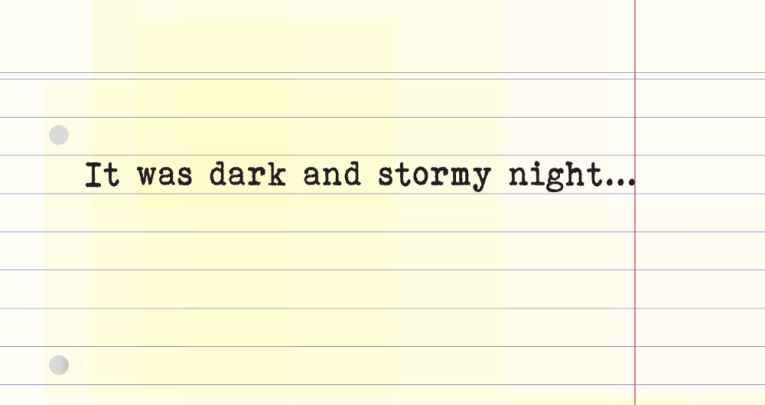
Boost primary pupils' fiction and non-fiction skills with these great descriptive writing examples, techniques, ideas, activities, prompts and more….

What is descriptive writing?
Descriptive writing can come in many forms, and is a useful tool for children to have. In creative writing they will need to describe characters, settings , emotions and feelings and more, while in non-fiction they may be describing people, places or events.
Even in instructional writing , descriptions need to be crystal clear for people to follow.
These resources cover using descriptive writing in a range of formats and styles, and will help them expand their vocabulary and grammar skills.
1 | Wild West story writing pack

This massive download pack contains materials designed to assist KS2 students with writing stories set within the period of the Wild West.
If children are to accurately portray a particular historical setting, they will require sufficient knowledge of the setting in question to clearly distinguish it from life in their own time, as well as the ability to describe it.
The pack includes short example texts, image prompts, ideas relating to town settings, outdoor settings, characters and objects/animals, a poster book and a PowerPoint presentation containing 21 slides of assorted Wild West-themed photography.
Ride off into the sunset with this resource here.
2 | Describing mood and tone worksheets
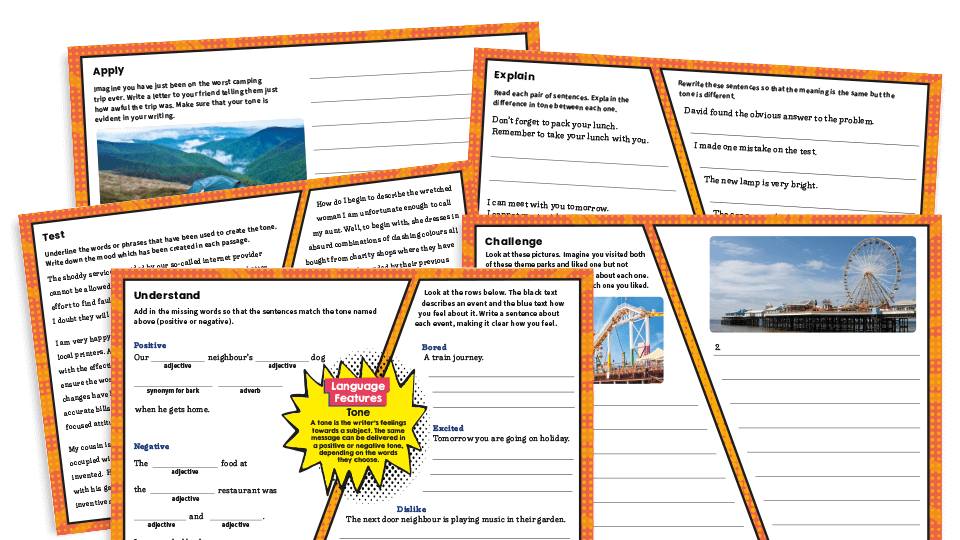
These writing features worksheet packs help children understand how language choice helps to describe things like mood and tone.
For example, it presents them with a short statement such as ‘Tomorrow you are going on holiday’ and asks them to write a sentence about it in an excited manner.
Or, it might say “There was a noise outside” and get them to write a sentence with a frightening tone.
Each one is divided into five sections to get children to understand, explain, apply, test and challenge what they’ve learned.
Click here to find the creating mood resource and the creating tone one
3 | Pie Corbett descriptive writing resources

Each of these Pie Corbett resources have been created specifically to help children with descriptive writing and feature original poems from Pie himself, as well as accompanying activities he has created.
There are three to be had. Just click these links to download:
- Space poems
- Animal poems
- Transport poems
4 | Powerful verbs features of writing worksheets
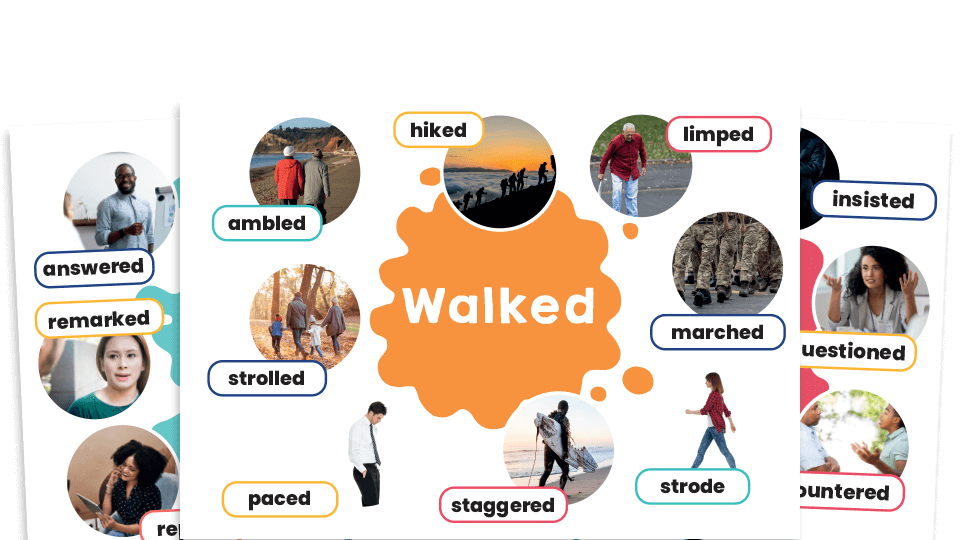
These resource packs help broaden children’s vocabularies by helping them to think of more-interesting verbs that will aid their descriptive writing.
There’s a worksheet pack , lesson pack and poster set .
5 | Ordering adjectives for descriptive words

Similarly, this ordering adjectives worksheet pack helps students understand the subtle differences between adjective synonyms so that they can use them accurately in their own writing.
It includes cards for sorting, and cloze procedure worksheets.
Get it here.
6 | Water safety writing packs
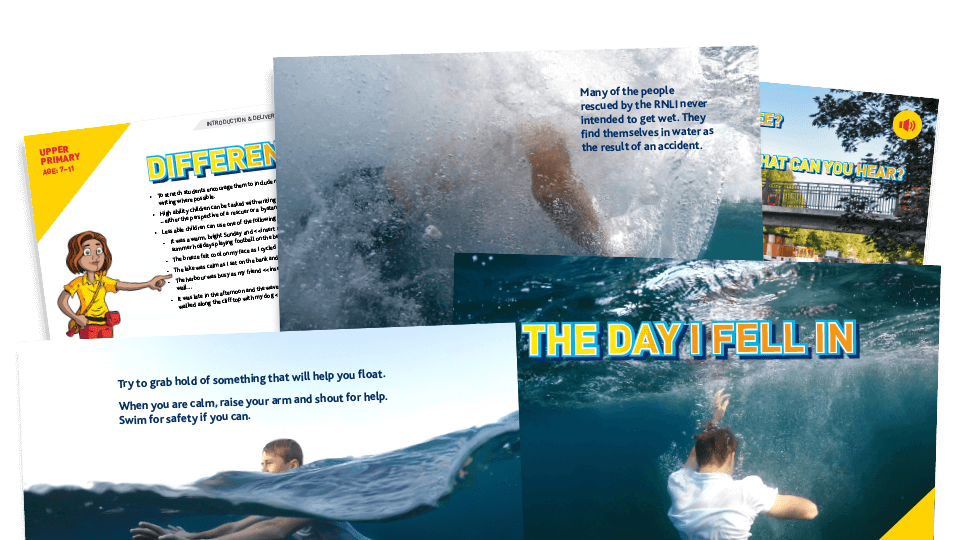
These resource packs from the Royal National Lifeboat Institute help children learn all about staying safe near water, all while improving writing skills.
The KS1 pack, for example, tasks Year 1 and 2 students with describing various waterside items, while the KS2 pack includes specially recorded soundscapes to help as writing prompts and gets them to write a short story about falling into the water, using all their senses to ‘show, not tell’.
Click here to download the packs for KS1 and KS2

7 | Descriptive writing techniques

Want to help your students build tension, atmosphere and build suspense in their writing ? These five descriptive writing ideas and examples from Alison Wilcox will help pupils use compelling language to keep the reader on the edge of their seat.
8 | Festive image bank

One for Wintertime, this image bank features 18 festive images in a PowerPoint presentation to use in descriptive writing exercises or as story starters.
Download it here.
Download more creative writing prompts .
Sign up to our newsletter
You'll also receive regular updates from Teachwire with free lesson plans, great new teaching ideas, offers and more. (You can unsubscribe at any time.)
Which sectors are you interested in?
Early Years
Thank you for signing up to our emails!
You might also be interested in...
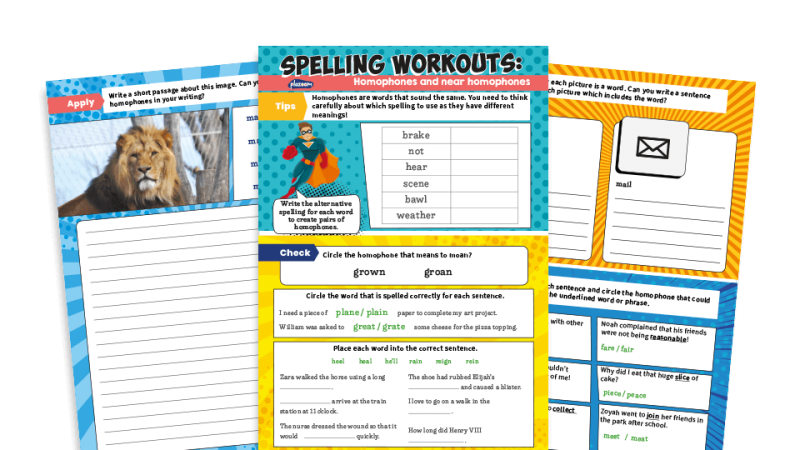
Why join Teachwire?
Get what you need to become a better teacher with unlimited access to exclusive free classroom resources and expert CPD downloads.
Exclusive classroom resource downloads
Free worksheets and lesson plans
CPD downloads, written by experts
Resource packs to supercharge your planning
Special web-only magazine editions
Educational podcasts & resources
Access to free literacy webinars
Newsletters and offers
Create free account
By signing up you agree to our terms and conditions and privacy policy .
Already have an account? Log in here
Thanks, you're almost there
To help us show you teaching resources, downloads and more you’ll love, complete your profile below.
Welcome to Teachwire!
Set up your account.
Lorem ipsum dolor sit amet consectetur adipisicing elit. Commodi nulla quos inventore beatae tenetur.
I would like to receive regular updates from Teachwire with free lesson plans, great new teaching ideas, offers and more. (You can unsubscribe at any time.)
Log in to Teachwire
Not registered with Teachwire? Sign up for free
Reset Password
Remembered your password? Login here


Descriptive Writing Task: How To Describe an Object
In this mini-lesson, I’ll go through the basics of how to describe an object in detail – and not just in a boring way! Many of the creative writing and descriptive writing questions in exams require you to focus on an object, person, place or thing.
Thanks for reading! If you find this useful, take a look at our full Basic Descriptive Writing and Advanced Descriptive Writing courses.
Lots of my students get stuck on description; they tell me that they can’t think of anything to write. Or they feel like they can only just list details or features of the object without being ‘creative’. So, if this is relatable for you then keep reading as we’ll be breaking down how to go beyond basic descriptions and transform them into something personal, powerful and meaningful.
Descriptive Writing: What is it and How to do it
Descriptive Writing Task:
- Look around you and choose an object . This should be something interesting – it might have a history to it or a memory attached. It might be complex or beautiful in some way. It might mean something important to you.
- Once you have picked the object, sketch it out using notes. What details do you notice there? Think about colour, shape, size, texture, patterns. How old or new is it? Has it been changed by humans at any point – maybe it’s broken or worn down? How does it make you think or feel? What memories or stories could you attach to it (these can be invented if you don’t have a real story or memory)?
- Write 2 paragraphs describing the object. Try to use as many techniques as possible. Write as quickly as you can. Each paragraph should be on a different topic. For instance, you might choose to structure this as the item now vs it in the past, physical description vs memory, or zooming in on different details.
- Edit your work. Could your descriptions be clearer in any way? Is there something you want to add or delete? Have you used enough techniques and a good range of different techniques rather than just repeating the same one? Have you used interesting punctuation, a variety of sentence lengths, a range of complex and specific vocabulary?
When doing this task with a student, I chose a candlestick that was on my desk. I decided to structure my paragraphs so that one was about the physical description of the candlestick, and the other was about its history and how it might have been made. Here’s my piece below:
A wax cylinder emerges from this candlestick, grey and ghostly – strange implacable colour; neither brown, nor black, nor white. Its burnt black wick curves slightly to the right, emerging out of a smoky pool of wax that has softened, melted and solidified again, into a curve – warped by the concentrated heat of a long snuffed-out flame. The monochromatic of the candle is directly opposed to the candlestick itself, which is awash with swirling patterns and colours, hand-painted onto a dark background and finished with a reflective gloss. Dust, however, has settled over its base and dulled the sheen to a milky pall over the bright colours below.
Far off, in an ancient land, I can imagine an old woman, sitting at her table in a village somewhere – perhaps in Siberia, Sweden or Finland. Wrapped in a patterned shawl to shelter herself from the biting Winter cold, she has only her fingerprints exposed, for dexterity, and in them, she holds an elegantly small paintbrush. The candlestick has been carved, turned and polished by her neighbour, and it is her task to transform it from a dull wooden object into something magical: a work of art. She paints luxurious crimson plums, bulbous yellow grapes (all perfectly circular) and intricate, swirling foliage that finishes off the folk art design. She will likely sell this object to a trader for a few pennies, perhaps enough to afford a measly potato soup for supper. Years later, I will purchase it as a fine antique in a high-end gallery, in an upmarket quarter of Harrogate, North Yorkshire.

Final Task: Review your work
Take a look back over your written piece, and do a short analysis of it – you can either write this out or just think about it. How successfully do you think the piece was? Are you happy with it? Why/why not?
Find three details that you are most proud of in your piece. Why are they great?
Find three details that could be improved. How would you improve them?
Thanks for reading! If you found this useful, take a look at our full Basic Descriptive Writing and Advanced Descriptive Writing courses, as well as other English Language and Literature courses.
Related Posts

The Theme of Morality in To Kill A Mockingbird

Unseen Poetry Exam Practice – Spring

To Kill A Mockingbird Essay Writing – PEE Breakdown

Emily Dickinson A Level Exam Questions

Unseen Poetry Exam Practice: The Man He Killed

How to Get Started with Narrative Writing

What do I need to do for AQA Language Paper 2?
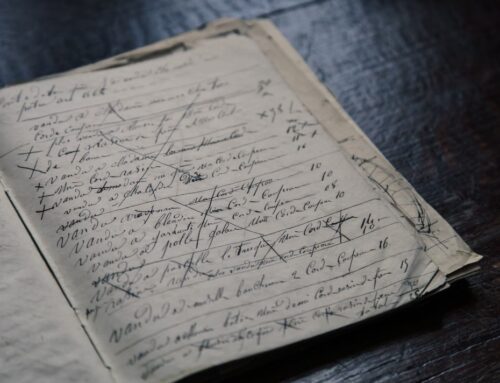
Fleance Character Analysis + Quotations

How to do well in the AQA GCSE Paper 2 Exam!

How to Write a Perfect Essay on The Crucible by Arthur Miller
© Copyright Scrbbly 2022
- Link to facebook
- Link to linkedin
- Link to twitter
- Link to youtube
- Writing Tips
How to Write a Descriptive Paragraph About a Person (With Examples)
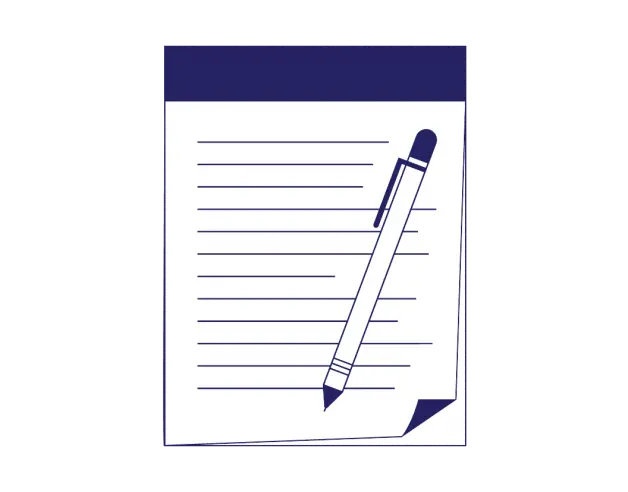
4-minute read
- 7th January 2023
Describing a person or character is difficult for even the most successful authors. It requires a balance of words to make sure they shine through without the language being too heavy. In this article, we’ll look at how to write a descriptive paragraph about a person, share some examples, and talk about different strategies.
1. Brainstorm Your Ideas
Brainstorming is crucial to any writing process. It’s the process in which you think of ideas for what you’d like to write about. In this case, you’re writing a descriptive paragraph about a person. It’s important to use adjectives to describe the features or characteristics you want to focus on.
One way to come up with ideas for a descriptive paragraph about a person is to go through the five senses. Use the questions below to get some ideas for what you want to highlight about your person.
Appeal to your reader’s senses – smell, taste, sound, sight, and touch
Smell: How does the person smell? Do they wear perfume? Are they doing an activity that would make them have a certain smell?
Taste: Do you associate a certain food with this person? Does it make you think of a specific taste? Can you taste something due to a certain smell they have?
Sound: Do they have a unique voice or laugh? Are they doing an activity that has distinctive sounds?
Sight: What prominent features do they have? For example, think about their dressing style, their smile, or their surroundings. What do you see them doing in your mind when you see a photo of them? What memories do you have of this person? Does this person remind you of something or someone?
Touch: What textures do you see? For example, imagine their skin or clothing. How does it feel if you hug them?
2. Begin With a Short and Snappy Sentence
Like with any type of writing, you want to hook your reader so that they want to continue reading. In this case, you can use a topic sentence, if appropriate, to introduce your reader to the person. For example:
Or, if you want to be more creative, you can reel them in with a short and snappy sentence about this person. This is called a writing hook . This sentence should focus on a stand-out detail or characteristic about the person you’re describing. For example:
3. Describe the Person
Now, this is the hard part. But, if you’ve brainstormed plenty of ideas and know which ones you want to focus on, it will be easier. Let’s look at some examples to get a better idea of how to write a descriptive paragraph about a person using the prompt “describe a person you admire.”
Comments: This paragraph is pretty typical of most students. It gives lots of visual details of the person and uses a simile or two (“ Her eyes are like the color of honey” and “Her smile shines like the sun” ). While this strategy gets the job done, it’s not very exciting to read. In fact, it can be quite boring!
Let’s look at how we can rewrite this to make it more exciting.
Find this useful?
Subscribe to our newsletter and get writing tips from our editors straight to your inbox.
Comments: In this example, we focused on one defining characteristic of the person we are describing — her laugh. This strategy places more focus on the person you’re describing, rather than the adjectives you use to describe them.
4. Edit and Revise
After you write your descriptive paragraph, be sure to read it over. Read it out loud. Read it in a funny voice. Doing this will help you to hear the words and identify which parts do not work or sound awkward.
5. General Tips for Descriptive Writing
● Avoid using too many descriptive words.
● Remember to show the reader, not tell.
● Appeal to the reader’s five senses – smell, touch, taste, sight, and sound.
● Focus on a striking or defining characteristic.
● Use contrasting details from other people or surroundings for emphasis.
● Use literary devices (metaphors, similes etc.) sparingly and with intention.
● Use a hook to reel your reader in.
● Use a variety of short and long sentences.
● Practice creative writing exercises to improve your descriptive writing skills.
● Always edit and revise your writing.
If you need more help with writing a descriptive paragraph or essay , send your work to us! Our experts will proofread your first 500 words for free !
Share this article:
Post A New Comment
Got content that needs a quick turnaround? Let us polish your work. Explore our editorial business services.
9-minute read
How to Use Infographics to Boost Your Presentation
Is your content getting noticed? Capturing and maintaining an audience’s attention is a challenge when...
8-minute read
Why Interactive PDFs Are Better for Engagement
Are you looking to enhance engagement and captivate your audience through your professional documents? Interactive...
7-minute read
Seven Key Strategies for Voice Search Optimization
Voice search optimization is rapidly shaping the digital landscape, requiring content professionals to adapt their...
Five Creative Ways to Showcase Your Digital Portfolio
Are you a creative freelancer looking to make a lasting impression on potential clients or...
How to Ace Slack Messaging for Contractors and Freelancers
Effective professional communication is an important skill for contractors and freelancers navigating remote work environments....
3-minute read
How to Insert a Text Box in a Google Doc
Google Docs is a powerful collaborative tool, and mastering its features can significantly enhance your...

Make sure your writing is the best it can be with our expert English proofreading and editing.
Descriptive Essay Writing
Descriptive Essay Examples

Amazing Descriptive Essay Examples for Your Help
Published on: Jun 21, 2023
Last updated on: Mar 1, 2024
-8521.jpg)
People also read
Interesting Descriptive Essay Topics - 2024
Writing a Descriptive Essay Outline - Tips & Examples
Descriptive Essay: Definition, Tips & Examples
Share this article
Descriptive essays are very commonly assigned essays. This type of essay enhances students' writing skills and allows them to think critically.
A descriptive essay is often referred to as the parent essay type. Other essays like argumentative essays, narrative essays, and expository essays fall into descriptive essays. Also, this essay helps the student enhance their ability to imagine the whole scene in mind by appealing senses.
It is assigned to high school students and all other students at different academic levels. Students make use of the human senses like touch, smell, etc., to make the descriptive essay more engaging for the readers.
On This Page On This Page -->
Examples make it easy for readers to understand things in a better way. Also, in a descriptive essay, different types of descriptions can be discussed.
Here are some amazing examples of a descriptive essay to make the concept easier for you.
Descriptive Essay Example 5 Paragraph
5 paragraphs essay writing format is the most common method of composing an essay. This format has 5 paragraphs in total. The sequence of the paragraphs is as follows;
- Introduction
- Body Paragraph 1
- Body Paragraph 2
- Body Paragraph 3
- Conclusion
Following is an example of a descriptive essay written using the famous 5 paragraph method.
5 Paragraph Descriptive Essay

Get More Examples From Our AI Essay Writer
Descriptive Essay Example About A Person
Descriptive essays are the best option when it comes to describing and writing about a person. A descriptive essay is written using the five human senses. It helps in creating a vivid image in the readerâs mind and understanding what the writer is trying to convey.
Here is one of the best descriptive essay examples about a person. Read it thoroughly and try to understand how a good descriptive essay is written on someoneâs personality.
Descriptive Essay Example About a Person
Descriptive Essay Example About A Place
If you have visited a good holiday spot or any other place and want to let your friends know about it. A descriptive essay can help you explain every detail and moment you had at that place.
Here is one of the good descriptive essay examples about a place. Use it as a sample and learn how you can write such an essay.

Tough Essay Due? Hire Tough Writers!
Descriptive Essay Example for Grade 6
Descriptive essays are frequently assigned to school students. This type of essay helps the students enhance their writing skills and helps them see things in a more analytical way.
If you are a 6 grader and looking for a good descriptive essay example, you are in the right place.
Descriptive Essay Example for Grade 7
Here is one of the best descriptive essay examples for grade 7.
Descriptive Essay Example for Grade 8
If you are looking for some amazing descriptive essay examples for grade 8, you have already found one. Look at the given example and see what a well-written descriptive essay looks like.
Descriptive Essay Example for Grade 10
Essay writing is an inevitable part of a student's academic life . No matter your grade, you will get to write some sort of essay at least once.
Here is an example of a descriptive essay writing for grade10. If you are also a student of this grade, this example might help you to complete your assignment.
Descriptive Essay Example for Grade 12
If you are a senior student and looking for some essay examples, you are exactly where you should be.
Use the below-mentioned example and learn how to write a good essay according to the instructions given to you.
Descriptive Essay Example College
Descriptive essays are a great way to teach students how they can become better writers. Writing a descriptive essay encourages them to see the world more analytically.
Below is an example that will help you and make your writing process easy.
College Descriptive Essay Example
Descriptive Essay Example for University
Descriptive essays are assigned to students at all academic levels. University students are also assigned descriptive essay writing assignments. As they are students of higher educational levels, they are often given a bit of difficult and more descriptive topics.
See the example below and know what a descriptive essay at the university level looks like.
Short Descriptive Essay Example
Every time a descriptive essay isn't written in detail. It depends on the topic of how long the essay will be.
For instance, look at one of the short descriptive essay examples given below. See how the writer has conveyed the concept in a composed way.
Objective Descriptive Essay Example
When writing an objective description essay, you focus on describing the object without conveying your emotions, feelings, or personal reactions. The writer uses sight, sound, or touch for readers' minds to bring life into pictures that were painted by words.
Here is an example that you can use for your help.
Narrative and Descriptive Essay Example
A narrative descriptive essay can be a great way to share your experiences with others. It is a story that teaches a lesson you have learned. The following is an example of a perfect narrative descriptive essay to help you get started.
Paper Due? Why Suffer? That's our Job!
How to Start a Descriptive Essay? - Example
If you don't know how to start your descriptive essay, check this example and create a perfect one.
How to Start a Descriptive Essay - Example
Subjective Descriptive Essay Example
It is a common concept that a descriptive essay revolves around one subject. Be it a place, person, event, or any other object you can think of.
Following is one of the subjective descriptive, easy examples. Use it as a guide to writing an effective descriptive essay yourself.
Writing a descriptive essay is a time-consuming yet tricky task. It needs some very strong writing, analytical, and critical thinking skills. Also, this is a type of essay that a student can not avoid and bypass.
But if you think wisely, work smart, and stay calm, you can get over it easily. Learn how to write a descriptive essay from a short guide given below.
How to Write a Descriptive Essay?
A writer writes a descriptive essay from their knowledge and imaginative mind. In this essay, the writer describes what he has seen or experienced, or ever heard from someone. For a descriptive essay, it is important to stay focused on one point. Also, the writer should use figurative language so that the reader can imagine the situation in mind.
The following are some very basic yet important steps that can help you write an amazing descriptive essay easily.
- Choose a Topic
For a descriptive essay, you must choose a vast topic to allow you to express yourself freely. Also, make sure that the topic you choose is not overdone. An overdone will not grab the attention of your intended audience. Check out our descriptive essay topics blog for a variety of intriguing topic suggestions.
- Create a Strong Thesis Statement
A thesis statement is the essence of any academic writing. When you select the descriptive essay topic, then you create a strong thesis statement for your essay.
A thesis statement is a sentence or two that explains the whole idea of your essay to the reader. It is stated in the introductory paragraph of the essay. The word choice for creating the thesis statement must be very expressive, composed, and meaningful. Also, use vivid language for the thesis statement.
- Collect the Necessary Information
Once you have created the thesis statement and are done writing your essay introduction . Now, it's time to move toward the body paragraphs.
Collect all necessary information related to your topic. You would be adding this information to your essay to support your thesis statement. Make sure that you collect information from authentic sources.
To enhance your essay, make use of some adjectives and adverbs. To make your descriptive essay more vivid, try to incorporate sensory details like touch, taste, sight, and smell.
- Create a Descriptive Essay Outline
An outline is yet another necessary element of your college essay. By reading the descriptive essay outline , the reader feels a sense of logic and a guide for the essay.
In the outline, you need to write an introduction, thesis statement, body paragraphs and end up with a formal conclusion.
Proofreading is a simple procedure in which the writer revises the written essay. This is done in order to rectify the document for any kind of spelling or grammatical mistakes. Thus, proofreading makes high-quality content and gives a professional touch to it.
You might be uncertain about writing a good enough descriptive essay and impress your teacher. However, it is very common, so you do not need to stress out.
Hit us up at CollegeEssay.org and get an essay written by our professional descriptive essay writers. Our essay writing service for students aims to help clients in every way possible and ease their stress. Get in touch with our customer support team, and they will take care of all your queries related to your writing.
You can always enhance your writing skills by leveraging the power of our AI essay writing tools .
Place your order now and let all your stress go away in a blink!
Barbara P (Literature)
Barbara is a highly educated and qualified author with a Ph.D. in public health from an Ivy League university. She has spent a significant amount of time working in the medical field, conducting a thorough study on a variety of health issues. Her work has been published in several major publications.
Paper Due? Why Suffer? That’s our Job!

Keep reading

Legal & Policies
- Privacy Policy
- Cookies Policy
- Terms of Use
- Refunds & Cancellations
- Our Writers
- Success Stories
- Our Guarantees
- Affiliate Program
- Referral Program
- AI Essay Writer
Disclaimer: All client orders are completed by our team of highly qualified human writers. The essays and papers provided by us are not to be used for submission but rather as learning models only.

The Top 20 Descriptive Paragraph Examples
Written by Dan
Last updated March 20, 2024
Are you tired of hearing your students say, “I don’t know how to write a descriptive paragraph!”? If so, you’re not alone! Writing compelling descriptions can be one of the most challenging parts for teachers and students.
But it doesn’t have to be so tricky! With suitable examples and guidance, anyone can become an expert in vividly describing people, places, things or events.
Before jumping into the deep end of resources out there, it’s a good idea for students to check out websites offering free essay samples, like StudyMoose .These platforms provide a wide range of free essays that can help students enhance their writing skills.
In this blog post, I will provide twenty stellar examples you can use as models for teaching your students how to write compelling descriptive paragraphs.
Related : For more, check out our article on Building Suspense In Writing here.
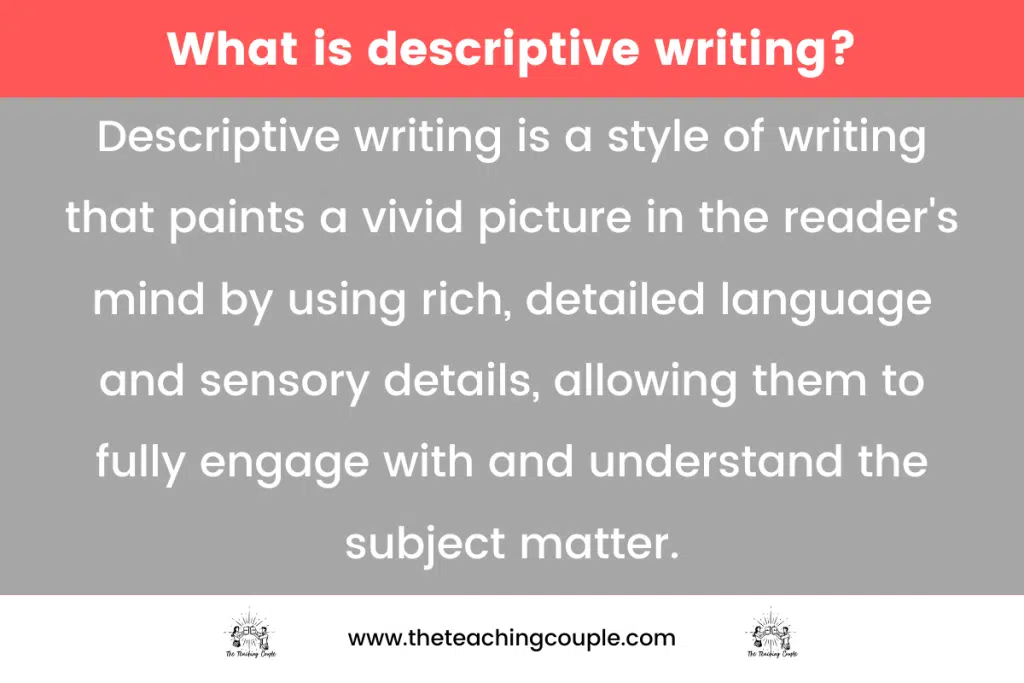
According to Grammarly , descriptive writing can enhance content, from an essay describing a historical event to a blog post narrating a personal experience.
IUP’s Writing Center further explains that effective descriptive writing evokes sights, smells, sounds, textures, and tastes, immersing readers in the narrative. But how does one master this craft?
Study.com provides a comprehensive lesson on the techniques and examples of descriptive writing, while LanguageTool offers insights into the illustrative writing style.
Table of Contents
Descriptive Paragraph Example 1:
The sun-kissed beach was a veritable haven. Soft, white sand stretched lazily from one end of the coastline to the other, inviting visitors to take off their shoes and dip their toes in the cool water.
Warm sunshine beat down on my skin as I walked along the smooth shoreline, enjoying the salty ocean breeze that greeted me with each step. In the distance, I could see boats anchored in the harbour, their masts swaying gracefully with the rhythm of the waves.
Descriptive Paragraph Example 2:
The older man shuffled slowly down the dirt road, a faded baseball cap pulled low over his eyes to shield them from the sun’s rays. He wore overalls and a flannel shirt, his hands calloused from years of hard work in the fields.
His face was craggy but kind- a life filled with stories hidden beneath the wrinkles that framed his eyes. I watched him as he walked, his steps light despite the weight of all he had seen.
Descriptive Paragraph Example 3:
The bustling city street was a melting pot of cultures, languages, and flavours. As eager shoppers stopped to examine their wares, merchants called out from their booths. Everywhere I looked, people were walking, talking, laughing- the occasional honk of a car horn punctuating the air.
The smells were a mix of mouthwatering cuisine from dozens of countries, the sound of different languages intermingling as the conversation drifted through the air.
Descriptive Paragraph Example 4:
The lush meadow was blanketed in soft green grass, punctuated with wildflowers in all rainbow colours. The sun shone brightly in the sky, warming everything beneath it with its gentle rays. In the distance, a stream babbled peacefully as birds chirped their songs from the trees that lined it.
The air was heavy with the sweet scent of honey, and I closed my eyes to take in all of its beauty.
Descriptive Paragraph Example 5:
The forest was alive with activity; small creatures skittered through the undergrowth while bright-coloured birds flitted from branch to branch overhead. A cool breeze caressed my skin and rustled through the leaves of nearby trees as I walked along the path, breathing deeply of the damp woodland air.
Everywhere I looked, lush greens and browns reminded me that life was flourishing here in this small corner of the world.
Descriptive Paragraph Example 6:
The ancient ruins surrounded a vast desert, their sand-covered stones looking out over miles of wind-swept dunes. I walked through the crumbling archway and into the courtyard, taking in the eerie silence that pervaded the entire site.
The sun beat down from above, its rays glinting off broken columns and walls that told stories of a forgotten time. Here was evidence of an ancient civilization that had disappeared into history.
Descriptive Paragraph Example 7:
The decrepit old mansion stood atop a hill like a silent sentinel watching over the valley below. Tall windows stared blankly from the walls, their glass panes long since shattered. The grounds were overgrown with weeds and wildflowers, a testament to the fact that no one had set foot here in many years.
I stepped through the doorway and into what felt like an entirely different world- a place filled with secrets and stories waiting to be discovered.
Descriptive Paragraph Example 8:
The silver moon shone brightly against the night sky, its reflection glittering on the lake’s still surface below. Fireflies sparkled around me like stars fallen from the heavens, their lights twinkling with those of distant galaxies.
Crickets chirped softly as they scuttled across my path while owls hooted in the distance. Everything felt peaceful and calm, like time had stopped to admire this magical moment.
Descriptive Paragraph Example 9:
The beach was a tranquil paradise, soft white sand stretching towards an endless blue horizon. The waves crashed gently against the shore, their foamy spray cooling my skin under the hot afternoon sun.
Seagulls hovered overhead, crying as they searched for food along the shoreline. Everywhere I looked, there was beauty; everything seemed perfect at that moment, from the towering palm trees to the sparkling sea below.
Descriptive Paragraph Example 10:
The snow-capped mountain peak rose majestically above me, its rocky sides glinting in the bright sunlight. I could feel the chill of the air around me and see my breath misting in front of me as I trudged up the steep path.
All was silent except for a few birds singing in the distance and the occasional avalanche tumbling down one of the nearby slopes. Everywhere I looked, there were breathtaking views and a sense of awe at being so close to such a powerful force of nature.

Descriptive Paragraph Example 11:
The sun was setting, painting the sky in vibrant shades of orange, pink and purple. The clouds were streaked with golden light, completing the brilliant spectacle that was taking place all around me.
I stopped to take it all in, feeling deep gratitude and awe at witnessing such a beautiful sight. All my worries seemed so far away at that moment; here, nothing else mattered but enjoying this fantastic view.
Descriptive Paragraph Example 12:
The dusty roads wound their way through the rolling hills of the countryside, lined by ancient trees whose roots had grown deep over centuries. Wildflowers flourished in splashes of colour against the backdrop of green fields and blue sky.
The air was sweet with the scent of fresh-cut hay and the buzzing of bees. There was a beauty that could only be found in nature, a timeless reminder of the power and magnificence of the world around us.
Descriptive Paragraph Example 13:
The city skyline glowed in all its glory against the night sky, its skyscrapers towering majestically above me. Cars whizzed by on crowded streets, neon signs flashing in their wake, while music drifted through the air from distant clubs and bars.
People bustled about their business with purpose and energy, carrying an infectious enthusiasm for life. Everywhere I looked, I saw evidence of progress and growth; it was a sight that reminded me just how vast and varied our world is.
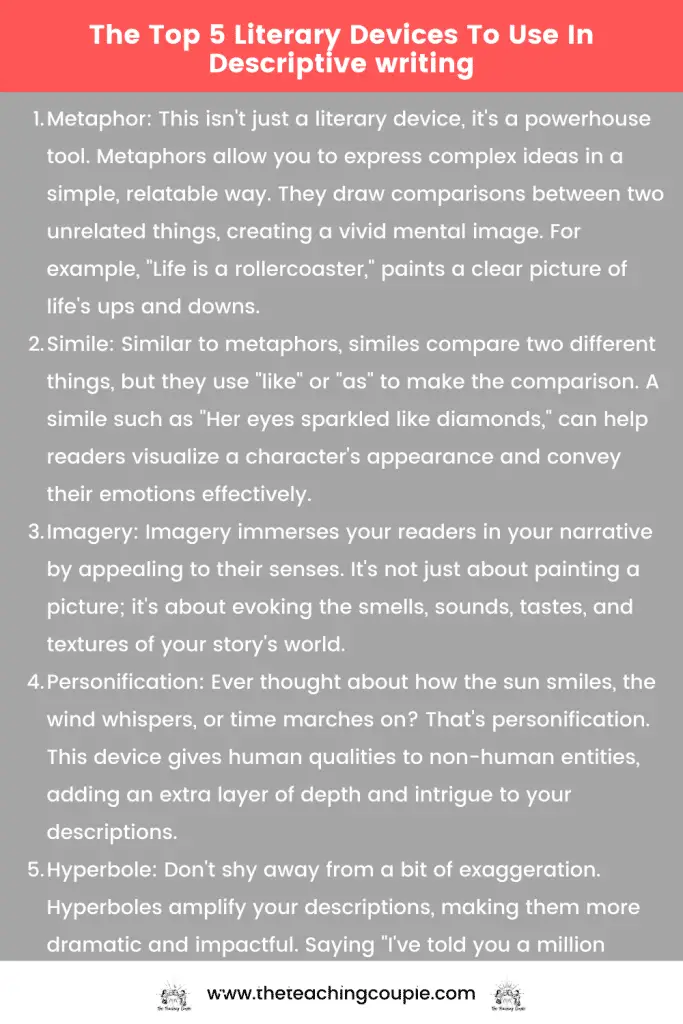
Descriptive Paragraph Example 14:
The desert stretched out before me, a vast expanse of red sand and sun-bleached rocks. The heat was oppressive but calming, the warm breeze carrying an earthy scent. In the distance, I could see dust devils whirling across the dunes, throwing up clouds of golden sand in their wake.
It felt like a place stuck in time, where one could take refuge from the frenetic pace of modern life and find solace in nature.
Descriptive Paragraph Example 15:
The forest was alive with sound and colour; birdsong filled the air while shafts of sunlight pierced through the canopy above, dappling the ground below with splashes of gold.
The trees stood tall and proud, their leaves rustling in the gentle breeze. Everywhere I looked, there was evidence of life; from the scurrying squirrels to the buzzing insects, it seemed as if everything had been frozen in perfect harmony and balance. It was an enchanting sight that made me feel profoundly alive.
Descriptive Paragraph Example 16:
The lake shimmered in the afternoon light, its still waters reflecting the clouds above. The sun shone brightly in a deep blue sky, making everything around me seem alive and vibrant. I could feel the warmth of the sand beneath my feet as I walked along the beach, watching the waves lap against the shoreline.
Everywhere I looked, there was beauty; from the towering mountains on either side to the lush greenery that covered them, it was an idyllic setting that filled my heart with joy.
Descriptive Paragraph Example 17:
The stars twinkled in all their glory above me, casting an ethereal glow over everything below. I stood in awe, my eyes searching the night sky for constellations. The moon shone brightly, its pale light illuminating the darkness and giving everything an otherworldly feel.
It was a breathtaking sight that reminded me of the power and mystery of our universe. Here I could escape from my troubles and bask in the beauty of nature’s grandeur.
Descriptive Paragraph Example 18:
The thunder roared as it rolled across the horizon, creating a rumbling sound that could be felt deep beneath my feet. Lightning crackled above, illuminating the sky with flashes of brilliant white light. The rain poured down in sheets, washing away all traces of dirt and dust from everything it touched.
This violent storm was both awe-inspiring and frightening in its intensity, a reminder of the unpredictability of nature. I felt as though I was witnessing something that could never be recreated; a moment of beauty and power that would stay with me forever.
Descriptive Paragraph Example 19:
The autumn air was crisp and clean, filled with the smell of fallen leaves and freshly cut wood. The last rays of sunlight cast an orange hue over everything, creating an ethereal atmosphere that seemed almost magical.
Everywhere I looked were vibrant red, gold, and orange shades as trees shed their leaves for the winter ahead. It was a beautiful sight that reminded me how quickly time passes and how we must cherish each moment before it slips away. It was a reminder of just how vast and varied our world is.
Descriptive Paragraph Example 20:
The snow fell softly from the sky, blanketing the world in a thick layer of white. C crystalline frost covered trees, and icicles hung from rooftops, their needles glistening in the pale moonlight.
Everything was still and silent; it felt like I was the only living soul for miles. With each breath, the cold air filled my lungs, and I savoured this moment of peace, so pure and untouched by modern life. This was nature at its finest, a reminder of how fragile our existence is.
1. What is descriptive language?
Descriptive language is a literary tool used by writers to paint vivid pictures in the reader’s mind. It involves using adjectives, adverbs, metaphors, similes, and other figurative language to describe a scene, person, or situation in detail.
2. Why is descriptive language important in descriptive paragraphs?
The essence of a descriptive paragraph lies in its ability to create a clear and vivid image in the reader’s mind. Descriptive language is instrumental in achieving this, as it adds depth, detail, and color to your writing, making it more engaging and relatable for your audience.
3. Can you give an example of descriptive language?
Absolutely! Consider this sentence: “The sun set over the ocean.” Now, let’s add some descriptive language: “The fiery sun slowly sank beneath the horizon, casting a golden glow over the tranquil, azure ocean.”
4. How can I improve my use of descriptive language?
Practice makes perfect! Try to incorporate descriptive language into your everyday writing. Read widely to expose yourself to different styles of descriptive writing. Experiment with various literary devices such as metaphors, similes, and personification.
5. Does using more adjectives and adverbs make my writing more descriptive?
Not necessarily. While adjectives and adverbs play a key role in descriptive writing, it’s essential to use them judiciously. Too many can make your writing seem overwrought and confusing. The goal should be clarity and precision.
6. How does descriptive language contribute to the tone of a paragraph?
Descriptive language can significantly influence the tone of a paragraph. For instance, using words like ‘gloomy’, ‘dreary’, or ‘haunting’ can create a dark or melancholic tone, while words like ‘vibrant’, ‘lively’, or ‘sparkling’ can evoke a more upbeat and positive tone.
7. Can descriptive language be used in all types of writing?
While descriptive language is most commonly associated with creative writing, it can be effectively used in almost all types of writing, including academic, business, and online content marketing, to engage readers and make the content more memorable. Remember, mastering descriptive language is a journey. Keep practicing, keep experimenting, and most importantly, keep having fun with your words. After all, isn’t that what writing is all about?
Related Posts

About The Author
I'm Dan Higgins, one of the faces behind The Teaching Couple. With 15 years in the education sector and a decade as a teacher, I've witnessed the highs and lows of school life. Over the years, my passion for supporting fellow teachers and making school more bearable has grown. The Teaching Couple is my platform to share strategies, tips, and insights from my journey. Together, we can shape a better school experience for all.

Join our email list to receive the latest updates.
Add your form here

IMAGES
VIDEO
COMMENTS
Descriptive Writing Write a description of a wood as suggested by this picture: REMINDER You must include: • a range of linguistic devices • a range of punctuation • ambitious vocabulary • varied structural features. Plan before you write. Consider what you need to include (specifically) and where you will include it; create a tick list.
Descriptive writing helps the reader visualize the person, place, thing, or situation being described. When a text conjures a vivid, sensory impression in the reader's mind, not only does it make the writing more interesting to read; it helps the reader understand the text better and recognize the author's intention more clearly.
Delightful Descriptive Writing Exercises and Worksheets Descriptive writing is an attempt to give a clear description of people, places, objects, or events using descriptive language and informative details. Descriptive writing exercises can include: brainstormingoutliningword sortingsentence writing with picturestransitions exercises 1 Descriptive essay outline template This is an essay ...
Descriptive writing activities encourage students to get creative and use their five senses, literary devices and diverse vocabulary. Read on for eight descriptive writing activities that you can adapt for any level and theme! Introduce your students to descriptive writing and amp up their English language skills.
For example, rather than say The man was old, say something along the lines of, The man's face was wrinkled with age. While the first sentence makes a statement about the man's age that tells the reader their age, the second shows the effect of age on the man's looks. Good descriptive writing needs to be specific, evocative, and believable.
Writing descriptively involves choosing your words carefully. The use of effective adjectives is important, but so is your choice of adverbs, verbs, and even nouns. It's easy to end up using clichéd phrases—"cold as ice," "free as a bird"—but try to reflect further and make more precise, original word choices.
Writing descriptively brings text to life. A writer could describe a person, location, object, event, emotion, the weather, an action, landscape and much more. Good descriptive writing allows the ...
How To Be Descriptive In Your Writing. There are several ways to use descriptive writing in your text. We'll cover a few of them below and provide examples. 1. Engage senses by using details. Adding specific details helps your readers visualize what you're writing about. The bakery smelled good. ↓.
Description in Rhetoric and Composition. In composition, description is a rhetorical strategy using sensory details to portray a person, place, or thing. Description is used in many different types of nonfiction, including essays , biographies, memoirs, nature writing, profiles, sports writing, and travel writing .
When writing a descriptive essay about a person or place, adding their personal traits will be helpful. Some examples of descriptive essay topics include: Compose a detailed descriptive essay about your best friend. Describe a fancy place that you have created. Describe your dream vacation destination.
The use of literary devices such as personification and metaphor makes the banyan tree in the second example come to life. This is how you can make your writing more vivid, descriptive, and poetic. 2. Use your senses. Sensory descriptors are one of the most important aspects of a descriptive essay.
Descriptive writing can come in many forms, and is a useful tool for children to have. In creative writing they will need to describe characters, settings, emotions and feelings and more, while in non-fiction they may be describing people, places or events. Even in instructional writing, descriptions need to be crystal clear for people to follow.
This video is a guided walk through of Language paper 1 Question 5.It offers top tips and explains how you can reach full marks easily!Watch the rest of the ...
Answering questions like these may seem like a straightforward task, but writing descriptive text can actually be a real challenge. Get it right and it will paint vivid images and hold your readers' attention; get it wrong and you run the risk of boring or confusing your readers. Articles. Videos. Instructors. Explore. Articles;
Write 2 paragraphs describing the object. Try to use as many techniques as possible. Write as quickly as you can. Each paragraph should be on a different topic. For instance, you might choose to structure this as the item now vs it in the past, physical description vs memory, or zooming in on different details. Edit your work.
1. Brainstorm Your Ideas. Brainstorming is crucial to any writing process. It's the process in which you think of ideas for what you'd like to write about. In this case, you're writing a descriptive paragraph about a person. It's important to use adjectives to describe the features or characteristics you want to focus on.
Descriptive Essay Example 5 Paragraph. 5 paragraphs essay writing format is the most common method of composing an essay. This format has 5 paragraphs in total. The sequence of the paragraphs is as follows; Introduction. Body Paragraph 1. Body Paragraph 2. Body Paragraph 3. Conclusion.
The style of your descriptive writing is closely related to the language you use. For example, the best descriptive writing responses show evidence of careful word choices and the deliberate but judicious use of linguistic techniques. Descriptive writing helps the reader to visualise the person, place, or situation being described.
There are 4 parts to the IELTS Writing Task 2 criteria. Task Response. Coherence and Cohesion. Lexical Resource (Vocabulary) Grammatical Range & Accuracy. Adapting your essay structure and vocabulary to suit a Descriptive or Position task will affect one key part of the criteria: Task Response. This is because you need to present an ...
Descriptive Paragraph Example 20: The snow fell softly from the sky, blanketing the world in a thick layer of white. C crystalline frost covered trees, and icicles hung from rooftops, their needles glistening in the pale moonlight. Everything was still and silent; it felt like I was the only living soul for miles.
Let's take this descriptive writing task as an example: "Describe trying to sleep before an important day.". We can use "panoramic, zoom, single line, shift, shift, panoramic" six-step structure to plan our response: Stage. Suggested techniques and details. Step 1. Panoramic.
One task will ask you to write descriptively, most likely based on the image, and the other question will ask you to write a story, based on a statement or title. ... Below is an example of the type of descriptive writing you may be asked to write in Question 5. This is taken from Language Paper 1 June 2019: This task asks you to describe a ...